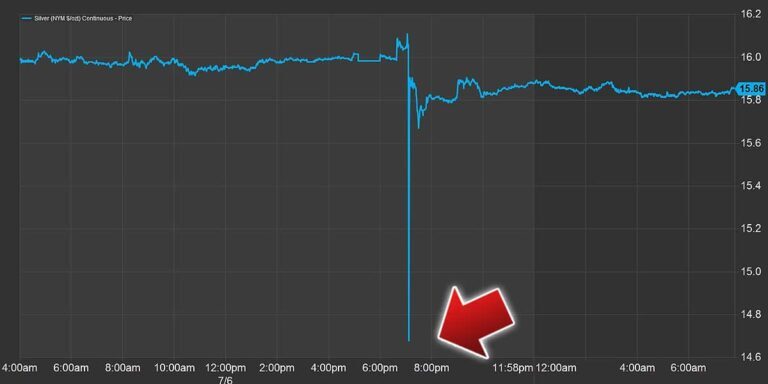
Was Government Behind the Silver Flash Crash?
At approximately 7:06 PM ET on July 6, COMEX Silver futures (Sept. contract) plunged 11 percent from $16.14 per troy ounce to $14.34 within just one minute.

So what caused this devastating blip in price? There are many possibilities. It could have been a technical glitch, a triggering of massive stop-loss orders by algorithmic programs at a time of extreme illiquidity, or it could be attributable to the classic “fat fingers” argument (safeguards of which make such an event highly unlikely these days).
But another potential cause lay in the possibility of the market having been manipulated. As for this, we cannot know for sure. The CME has remained silent about the matter. And to this day, they have made no statement regarding any findings during their investigation.
Instead, the CME stated that upon initiating a 10-second halt during the crash, they reviewed the trades and made a series of price adjustments. These quick price adjustments imply that such an event was not considered a “normal” aspect of market operations; that perhaps they found evidence of something indicating either a grievous error or market manipulation.
Would it seem outlandish to suspect that government had something to do with the crash?
To be clear, we’re not insinuating that government was somehow responsible. But at the same time, we’d also like to question any line of thinking that would relegate such suspicions to conspiracy theory rather than reason.
Precious metals expert James Turk believes that the government engineered the plunge “to scare investors to part with their silver and gold.”
“They want investors to think that gold and silver are volatile assets that are better left alone. The manipulators want investors to avoid gold and silver, not own them. Their overall aim is to make investors believe that fiat currency is superior to precious metals and that gold and silver’s 5,000-year history as money is an aberration.”
He continues: "The timing was purposefully chosen. It was all paper. No physical metal traded. The manipulators couldn't risk starting a flash crash during normal market hours when the physical market is trading because they did not want the risk of having to fill orders from buyers of physical metal during the flash crash.”
In other words, if the manipulators had to fill buyers’ orders, something that might have happened had they dumped silver contracts during regular market hours, they consequently might have had to fill orders with their own stock of physical metal.
Are Turk’s suspicions unfounded? Does government have a reason to dissuade Americans from trading their fiat currency for silver and gold? Does the government use its powers to manipulate the monetary system? Does government use fear and legal forms of coercion to intervene with the financial holdings and activities of its citizens? These are all rhetorical questions. And the suspicions they raise about government’s interests make it easy to attribute such market anomalies to their doing. Of course, without proof, it’s just theory. Turk’s point: the CME should shed light on what had happened.
The Silver Plunge May Be Near Completion
For short-term speculators long on silver, 2017 has thus far proved a challenging year. The US Dollar has weakened, cryptocurrencies (seen by many younger investors as an alternative to precious metals) have taken the spotlight--their prices skyrocketing, and upward movement in precious metals have been subtle to stagnant despite geopolitical and economic uncertainties.
Having sunk below its $15.90 support level, silver looks like a falling knife. However, there is a reason to believe that silver is approaching the end of a 19-month correction. According to Marc Cudmore, Bloomberg’s macro commentator:
“If the rise in global yields persists, then severe spillover effects in other asset markets could prompt a bid for precious metal havens again. So we are approaching the point where both higher yields and lower yields have the potential to boost the asset class.”
From a technical perspective, silver is also supported by a 31-month upward trendline--a level that is currently being tested.
When it comes to holding sound assets for the long term, such movements present opportunities to buy precious metals at value prices. Short to intermediate-term volatility is primarily the domain of speculators, most of whom do not take physical delivery as they have little interest in holding the metals. The value they seek (immediate “cash” profit) stands in stark contrast to that of the investor, who finds value in the wisdom and safety of holding sound assets.












